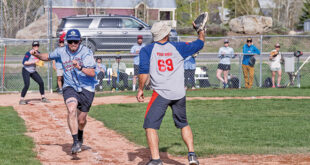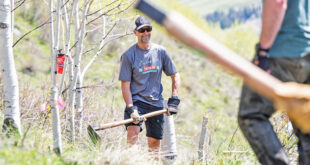Gunnison County’s Olympians share their trips to the top-and give tips on how you can get there too.
At least by population, Gunnison County is a very small pond. But surely by any measure it has a lot of good athletes—including an inordinate number of former Olympians.
For this issue and next, the Crested Butte News celebrates these Olympians, and asks for a bit of advice for aspiring champions and everyday athletes.
Susan DeMattei,
Mountain Biking:
Atlanta 1996
Although Susan DeMattei fell in love with the Olympics and gymnast Nadia Comaneci when she was little, the 1996 mountain bike bronze medalist says she never saw herself as a potential Olympian until she started excelling in cycling in her early 30s. In fact, out of five siblings, she was the only one who didn’t participate in high school sports.
But cycling, says DeMattei, is the perfect sport for an older athlete because it takes the experience and strength that comes with maturity. “You don’t have to start at 16 years old,” she says.
The first time the Marin County, Calif. native saw Gunnison, she didn’t understand what her then-teammate, boyfriend and Gunnison resident Dave Wiens saw in the place. “I didn’t get it,” says DeMattei. “I wondered what Dave was doing here.”
But DeMattei says when her relationship with Wiens evolved from dating to something more serious, her future in the valley was set. “Dave wasn’t going to move to California,” she says.
DeMattei says she now understands why she couldn’t pull Wiens away from Gunnison. And now she can’t imagine herself anywhere else. “I love it,” she says.
DeMattei says her Olympic experience was wonderful—especially since it was held in the United States. “It was kind of like being the home team at a football game,” she says. “The support was fabulous.”
The best part of all, says DeMattei, was coming across the finish line and seeing her husband, who was also the Olympic course designer. “Dave was so excited and happy,” says DeMattei.
DeMattei has this advice for aspiring Olympians and over-the-hill athletes who still want to improve. “Set small, achievable goals,” she says.
DeMattei says it’s useful to get involved in competition, even at the lower level. “It doesn’t have to be a big event, but you’ll see improvement if you work toward an obtainable objective,” she says.
Wendy Fisher,
Alpine Skiing:
Albertville, France 1992
Alpine skier Wendy Fisher’s 1992 Olympic experience in Albertville, France didn’t go quite as smoothly as DeMattei’s Atlanta run, but it was still just as memorable. Fisher had a terrifying crash in the downhill leg of the Alpine combined event that was televised repeatedly.
“I replaced the crashing ski jump guy for Wide World of Sports ‘agony of defeat,’” she says.
Unfortunately the crash put Fisher out of the slalom portion of the combined event, and she didn’t recover in time for the other event she qualified in, the Giant Slalom. Still, the Olympics are considered the pinnacle of athletic achievement and only the best skiers in the world have a chance to qualify for a powerhouse team like the women’s U.S. Alpine Olympic team.
Fisher says she started her alpine career early, making the national team when she was 15.
Although she has had an illustrious ski career—including seven years on the U.S. Ski Team, winning the overall at the National Championships in 1991 and numerous victories in extreme skiing events—she says it was her come-from-behind performances that were most memorable.
“Starting in the 50s in one of my first World Cups in Strum, Austria, I came in 13th,” she says.
Now a free ride and extreme skiing coach for the Crested Butte Academy, Fisher says she still works on her skiing every time she goes out. And it turns out, some of the things she works on would help a skier at just about any level. "I think about being relaxed," she says.
Fisher says she concentrates on avoiding getting off-balance by letting her weight get too far back. “I’m thinking about putting forward pressure on my skis, without bending over at the waist,” she explains.
She also advises skiers to focus on where they are going. “Look ahead,” she says.
Jenny Stillo,
Cross-Country Skiing: Albertville, France 1992
Coming from the tiny, snowless country of Honduras, Jenny Stillo made an unlikely winter Olympian. But when the Honduran Olympic Committee got wind of Stillo’s cross-country skiing exploits, they encouraged her to represent Honduras at Albertville in 1992.
Stillo had come from her home in Central America to Gunnison to attend Western State College in 1980. But life got in the way and she never left. Although she only skied a few times in college, by the time the Albertville Olympics came around, Stillo had become an accomplished Nordic skier.
“The Olympic Committee had read about my results in the Salomon (cross-country ski) Series and they called me. It was an opportunity not to be missed,” she says.
Stillo says the thing that differentiates the Olympics from a World Championship or a World Cup is that the smaller countries are given an opportunity to compete in the Olympics. And being a Honduran competing in skiing at a winter sports-crazed venue like Albertville was like being on the Jamaican bobsled team, Stillo says. “The people loved it.”
She competed in the 15-kilometer pursuit, which started with a five-kilometer classic leg, and finished with a 10-kilometer freestyle leg. Stillo says she didn’t expect to be among the leaders.
“I was participating, rather than competing,” she says.
But by becoming Honduras’ first-ever winter Olympian, Stillo was honored with an official postage stamp.
“You don’t have to die to be featured on a stamp like you do here,” she says.
For others who have Olympic-sized aspirations, Stillo advises thinking big. “Follow your dreams,” she says.
Jim Harlan,
Handcycle Road Race and Time Trial:
Athens, Greece 2004
Jim Harlan is a world-class cyclist and expert skier. And the 16-year Crested Butte Ski Patrol veteran does it all as a C-6 quadriplegic. “Quadriplegic means impairment in four limbs,” he explains.
Harlan was headed to Western State College on a full track scholarship, but his plans changed abruptly when he dived into a shallow pool.
Although his intention to attend Western State was derailed due to his injury, he came to live in the valley permanently after finishing school on the Front Range.
After a friend got him into handcycling, Harlan just took off, capturing the World Championship Road Race in Germany in 2002 as well as two U.S. National Championship road race titles. Harlan also completed the 400-mile Ride of the Rockies on his handcycle.
Besides his genetic gifts, Harlan attributes his strength to living in the mountains and getting around solely by muscle power.
“I don’t drive,” he says. “And living at 9,000 feet probably helps,” he adds.
Harlan says coming into the Olympics as world champion added another layer of tension to his Olympic experience. But despite some health issues leading up to the games that cost him an excellent performance, he says it was an adventure well worth undertaking. “It was a great experience,” he says.
He says the road race course, staged in the Vouliagmeni area in the south of Athens, was difficult due to strong sea breezes and hills.
“That made it more interesting, though,” says Harlan.
Harlan notes that the United States was nearly the only country in the world that didn’t televise the Para-Olympic portion of the 2004 Olympics. “It’s a shame, because people could have learned a lot,” he says.
Harlan says every endurance athlete inevitably hits a wall of pain when they near their maximum threshold, but he says a mental exercise can help transcend that pain.
“Try to think beyond it,” he advises. “Think about the pain later.”
Check out next week’s Crested Butte News to read other Olympic moments from Gunnison County athletes.
 The Crested Butte News Serving the Gunnison Valley since 1999
The Crested Butte News Serving the Gunnison Valley since 1999


